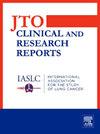SCLC和大细胞神经内分泌癌的诊断和治疗前景如何?
IF 3.5
Q2 ONCOLOGY
引用次数: 0
摘要
SCLC是一种预后不良的高级别神经内分泌恶性肿瘤,占全球肺癌病例的15%。遗传图谱的进展表明,SCLC是一种分子异质性疾病,根据其神经内分泌和免疫相关特征可分为SCLC- a、SCLC- n、SCLC- p和SCLC- i等亚型。这种异质性强调了定制治疗策略的必要性。大细胞神经内分泌癌(LCNEC)与SCLC具有组织学和分子相似性,但仍然是一个不同的实体。LCNEC分为两大亚型:I型,以STK11和KEAP1突变和神经内分泌表型为特征;II型,以TP53和RB1改变为特征,具有较高的增殖指数。LCNEC的罕见性和分子多样性为标准化治疗带来了挑战,进一步强调了与SCLC进行比较研究的必要性。在这篇综述中,我们强调SCLC和LCNEC的遗传和临床病理特征。此外,我们还讨论了SCLC和LCNEC治疗的新疗法和未来发展方向。本文章由计算机程序翻译,如有差异,请以英文原文为准。
What Is On the Horizon for the Diagnosis and Treatment of SCLC and Large Cell Neuroendocrine Cancer?
SCLC is a high-grade neuroendocrine malignancy associated with poor prognosis, comprising 15% of lung cancer cases globally. Advances in genetic profiling have revealed that SCLC is a molecularly heterogeneous disease, categorized into subtypes such as SCLC-A, SCLC-N, SCLC-P, and SCLC-I, on the basis of their neuroendocrine and immune-related characteristics. This heterogeneity underscores the need for tailored therapeutic strategies.
Large cell neuroendocrine carcinoma (LCNEC) shares histologic and molecular similarities with SCLC but remains a distinct entity. LCNEC is categorized into two major subtypes: Type I, characterized by STK11 and KEAP1 mutations and a neuroendocrine phenotype, and Type II, defined by TP53 and RB1 alterations with higher proliferative indices. LCNEC's rarity and molecular diversity present challenges for standardized treatment, further highlighting the need for comparative research with SCLC.
In this review, we highlight the genetic and clinicopathologic features of SCLC and LCNEC. Furthermore, we discuss emerging therapeutics and future directions in the treatment of SCLC and LCNEC.
求助全文
通过发布文献求助,成功后即可免费获取论文全文。
去求助
来源期刊

JTO Clinical and Research Reports
Medicine-Oncology
CiteScore
4.20
自引率
0.00%
发文量
145
审稿时长
19 weeks
 求助内容:
求助内容: 应助结果提醒方式:
应助结果提醒方式:


